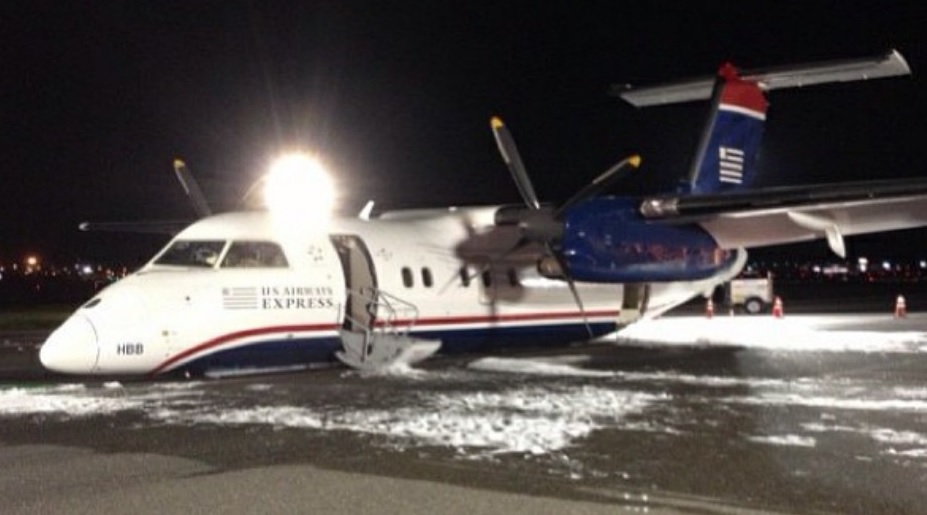Frozen Dash 8-100 Landing Gear After ‘Improper Maintenance Practices’ Say NTSB (Piedmont / US Airways Express Dash 8-100 N934HA at Newark)
On 18 May 2013 Piedmont Airlines Bombardier DHC-8-102 / Dash 8-100, N934HA, operating as US Airways Express flight 4560, was forced to land with the landing gear retracted at Newark Liberty International Airport (EWR), New Jersey. The 34 people onboard were uninjured but the aircraft damage was classified as “substantial”.

Piedmont / US Airways Express Bombardier Dash 8-100 N934HA at Newark after Wheel Up Landing (Credit: Sugznj)
The US National Transportation Safety Board (NTSB) explain in their safety investigation report (issued 22 September 2020, 89 months later!) that:
About 2325 [Local Time] , the flight was cleared for an instrument landing system (ILS) approach to runway 4R at EWR. When the crew attempted to lower the landing gear, the left MLG [Main Landing Gear] showed a red unsafe indication in the cockpit. The captain received approval from an EWR air traffic control tower controller to perform a “fly-by”; the tower confirmed that the left MLG appeared to be partially extended.
The crew put the aircraft in a holding pattern at 3000 ft, completed the appropriate checklists and liaised with the airline’s duty maintenance control supervisor by radio. Their troubleshooting did not succeed.
When the fuel remaining was 900 lbs, the captain decided to make an emergency landing with all landing gear retracted, and the maintenance personnel agreed. The captain made a passenger address announcement, briefed the FO on the planned landing, and called for the emergency landing checklist. In accordance with the checklist, he pulled the B3 GPWS circuit breaker (CB).
The captain flew the ILS approach to runway 4L.
The landing gear warning horn did sound during the approach. The First Officer described it as “extremely distracting”.
The airplane landed [at 0104 Local Time] about 3,000 ft down the runway and slid about 2,000 ft, stopping on the runway centerline in a wings-level attitude.
An evacuation was conducted through the forward doors without injury.
The NTSB Safety Investigation
The NTSB explain that both flight crew had reported for duty at 1255. The captain was undertaking his 6th sector of the day. Both reported they were well rested before reporting for duty and were “not affected by fatigue or other personal issues”.
Bombardier Quick Reference Handbook (QRH) does also call for the CB for the horn be pulled before any gear up landing.
When the FO was asked if he read the entire checklist, including the warnings, cautions and notes, he stated he got distracted because the checklist said “verify three green lights illuminated.” The three lights were not there, and there was nowhere to go from there. At that point he was unsure about reading the rest of the checklist.
Examination of the MLG showed that…
…neither landing gear displayed visible physical damage. However, the left MLG uplock roller was found seized and would not rotate by hand. The right MLG uplock roller could be rotated by hand.
On the latch of both the left and right MLG uplocks, a “worn” groove was noted on the lower surface of the latch. The groove in the left uplock latch appeared slightly larger than the groove in the right uplock latch. The grooves on the left and right uplock latch were measured. A comparison of the measurements of the grooves against the landing gear manufacturer’s specifications showed that the groove on the left MLG uplock latch was at or beyond wear limits, and the groove on the right MLG uplock latch was at or slightly below wear limits.
A test of the alternate landing gear extension system showed the left MLG required a manual force of more than 240 lbs to activate. NTSB note “a 186-lb Piedmont captain sitting in the FO’s seat could not release the left MLG, even by ‘hanging’ from the T-handle (i.e. pulling himself up from the seat)”.
Removal of the left MLG uplock roller revealed that the internal roller bearings had rust on the internal surfaces, the internal pin had marking signatures that appeared to have transferred from the roller bearings, and the bearing seal also appeared to be compromised. The roller was cleaned, lubricated, and then installed on the right MLG for a test; the right uplock roller was moved to the left MLG.
The normal and alternate MLG extensions were then achieved successfully. Components were then sent for examination at an OEM facility.
The MLG uplock assembly was visually inspected and appeared to be in good condition with dirt deposits but no visible damage. The worn groove on the uplock latch was noted.
The uplock roller assembly was visually inspected. There was visual evidence of wear on the outer diameter of the roller, and a dimensional check of the roller assembly according to the manufacturer’s specifications indicated that the outer diameter measurements were within the specified limits. In addition, the internal “needle” bearings were inspected.
One set of the bearings appeared out of alignment, and several needle bearings were noted to have flat spots and corrosion. The bearing assembly appeared to be devoid of lubricant, and when placed onto the shoulder bolt and rotated, the bearing did not rotate smoothly.
The uplock roller assembly shoulder bolt was also examined, and two areas of wear were noted, corresponding to the areas where the uplock roller assembly seals would contact the bolt. The shoulder bolt diameter measurements conformed to the manufacturer’s specifications.
The NTSB investigation turned to the maintenance history:
Examination of Piedmont’s maintenance procedures indicated that a visual inspection of the MLG uplock actuator latch for wear was conducted in each of the B checks, which Piedmont conducted every 440 flight hours. The last B check was accomplished on March 21, 2013.
Piedmont also provided the certification of the uplock latch assembly. The certification provided documentation of the last time the worn groove on the uplock latch was measured. The latch groove was last measured on December 9, 2003, and was determined to be within tolerance. The inspector would have measured the groove using the manufacturer’s Uplock Assembly Component Maintenance Manual instructions. Piedmont indicated that the MLG uplock latches were tracked but only removed on condition.
Further, Piedmont’s maintenance procedures included a maintenance task to inspect the MLG uplock roller assembly every 220 flight hours. The task card instructions specified that, if the roller was seized or rotation was difficult, lubrication of the roller was required. For the accident airplane, the left MLG uplock roller was inspected 11 times (2,723 hours) and did not require lubrication.
Operator Post-Accident Actions
Maintenance changes included a fleet-wide campaign to inspect and lubricate the roller assembly and to accomplish an operational check of alternate extension; a revised work card for the uplock actuator inspection, with a reference for uplock wear limits and an addition of roller inspection; publication of a bulletin to add the use of dental mold to measure the dimensions of the uplock groove; creation of a stand-alone task to lubricate the uplock roller every 500 hours; revision of a work card to refer to the Aircraft Maintenance Manual for the procedure to lubricate the uplock roller; and revision of the flight crew and maintenance controller walkaround inspection to include physically checking the freedom of the rollers.
In addition, Piedmont modified and enhanced the Alternate Landing Gear Extension Checklist making it no longer a memory item; modified the Forced Landing Checklist; added a new checklist titled Landing Gear Fails to Extend that contains the information in the Bombardier Safety of Flight Supplement No. 14; published a Flight Information Letter to all crewmembers requiring inspection of the MLG uplock roller during the originating preflight; and improved the communications procedures between the flight crew and dispatch/maintenance during inflight troubleshooting events.
NTSB Probable Cause
The frozen left MLG uplock roller due to lack of lubrication and the uplock latch that had worn beyond acceptable tolerances, which prevented the flight crew from extending the left MLG using the alternate extension system.
Contributing to the accident were the operator’s improper maintenance practices, which did not detect the lubrication issue with the roller and the wear of the latch.
Safety Resources
Past Aerossurance articles include:
- Professor James Reason’s 12 Principles of Error Management
- Back to the Future: Error Management
- Aircraft Maintenance: Going for Gold?
- Airworthiness Matters: Next Generation Maintenance Human Factors
- B1900D Emergency Landing: Maintenance Standards & Practices
- Maintenance Human Factors in Finnish F406 Landing Gear Collapse
- Lost in Translation: Misrigged Main Landing Gear
- ERJ-190 Flying Control Rigging Error
- Beech 99A MLG Collapse
- Beechcraft 1900C Landing Gear Collapse at San Antonio, TX
- CRJ-200 Landing Incident Highlighted US Maintenance Competency Inadequacies
- A Lufthansa MD-11F Nose Wheel Detached after Maintenance Error
- B747 Landing Gear Failure Due to Omission of Rig Pin During Maintenance
- When Down Is Up: 747 Actuator Installation Incident
- Myanmar National Embraer 190 NLG Jam: Maintenance Error? We’re Not Convinced!
- US Dash 8-100 Stalled and Dropped 5000 ft Over Alaska
- Fuel System Maintenance Error: Tuniter ATR72 TS-LBB Ditching 6 August 2005
- Dash 8 Runway Excursion after Unstable Crosswind Approach – Danish AIB Report
- ATR72 Cognitive Bias Leads to Control Problems
- Runway Excursion Exposes Safety Management Issues
- G200 Leaves Runway in Abuja Due to “Improper” Handling
- CRJ900 Skids Sideways Down Finnish Runway
- Boeing 737-800 Engine Nacelle Strike and Continued Operation
- UPDATE 12 October 2020: Runaway Dash 8 Q400 at Aberdeen after Miscommunication Over Chocks
UPDATE 7 October 2020: Aerossurance was to have run training workshops at the EHA European Rotors VTOL Show and Safety Conference in Cologne in November 2020 on a) Safety Culture and Leadership and b) Contracting Aviation Services: An Introduction to the Basics. Sadly the event has been postponed to 2021.


Recent Comments